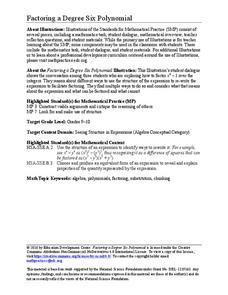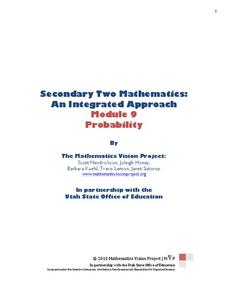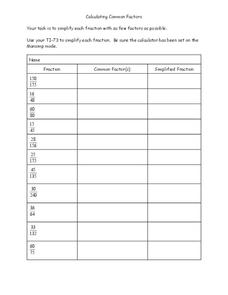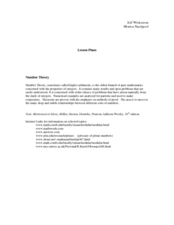EngageNY
Law of Cosines
Build upon the Pythagorean Theorem with the Law of Cosines. The 10th part of a 16-part series introduces the Law of Cosines. Class members use the the geometric representation of the Pythagorean Theorem to develop a proof of the Law of...
Education Development Center
Factoring a Degree Six Polynomial
Within collaborative groups, scholars factor a degree six polynomial. They can factor the polynomial using many different strategies — a great way to prompt mathematical discussion.
EngageNY
Discovering the Geometric Effect of Complex Multiplication
Does complex number multiplication have the class spinning? Here's a resource that helps pupils explore and discover the geometric effect of multiplying complex numbers. In the 14th installment in the 32-part unit groups look at the unit...
West Contra Costa Unified School District
Simplifying Radicals – Day 1
It doesn't get simpler than this. Scholars first learn to simplify radicals by determining the prime factors of the radicand. The instructional activity progresses to simplifying radicals involving algebraic expressions in the radicand.
EngageNY
Four Interesting Transformations of Functions (Part 1)
Understanding how functions transform is a key concept in mathematics. This introductory lesson makes a strong connection between the function, table, and graph when exploring transformations. While the resource uses absolute value...
Teach Engineering
Bone Mineral Density Math and Beer's Law
Hop into a resource on Beer's Law. A PowerPoint presentation introduces Beer's law as part of calculating bone density from X-ray images in the sixth instructional activity in the series of seven. Individuals work on practice problems...
Mathematics Vision Project
Probability
Probability, especially conditional probability, can be a slippery concept for young statisticians. Statements that seem self-evident on the surface often require a daunting amount of calculations to explicate, or turn out to be not so...
West Contra Costa Unified School District
Solving Exponential Equations
The power to solve exponential equations lies in the resource. Scholars first learn how to solve exponential equations. An activity matching cards with equations, intermediate steps, and solutions strengthens this skill.
Howard County Schools
Factoring Trinomials Using Tiles
What's the opposite of multiplying binomials? Learners apply their previous knowledge of multiplying binomials using algebra tiles to factor trinomials. The lesson introduces factoring as a process that uses algebra tiles to...
Statistics Education Web
The United States of Obesity
Mississippi has both the highest obesity and poverty rate in the US. Does the rest of the data show a correlation between the poverty and obesity rate in a state? Learners tackle this question as they practice their skills of regression....
Education Development Center
Anita's Way to Add Fractions with Unlike Denominators
Could you develop your own way to add fractions with unlike denominators? An in-depth task has scholars examine a fictional conversation between several people in which they discuss a method of adding fractions with unlike denominators....
Curated OER
Calculating Common Factors
In this middle school mathematics worksheet, students use a TI-73 calculator to identify the common factors of the numerator and denominator of a fraction and reduce the fraction to lowest terms. The one page worksheet contains eleven...
Mathed Up!
Algebraic Fractions
Learn ways to simplify algebraic fractions with a video that reviews how to simplify rational expressions by canceling common factors and how to add and subtract simple rational expressions. A worksheet tests pupils' understanding of the...
Curated OER
Number Theory
Learners explore the concept of number theory. They discuss an assortment of number theory topics such as prime numbers, composite numbers, GCF, modular arithmetic, and others in a lecture style discussion. Pupils view videos about these...
Curated OER
Simplify the Fractions
In this reducing fractions to their lowest terms worksheet, students find the common factors, identify the largest common factors, and simplify the fractions.. Students solve 12 problems.
Curated OER
Simplify Fractions
In this reducing fractions worksheet, students find the common factors to reduce fractions to their lowest terms. Students solve 12 problems.
Curated OER
Mountain Math Worksheet
In this number sense instructional activity, 5th graders solve 37 problems based on a given number. Students are asked to round the number, identify the number as even or odd and add 100 to the number.
Curated OER
Math--Fractions and Percentages
In this fractions and percentages worksheet, learners write down the percentages of a pie chart and change then into fractions. Students change 7 fraction sentences into a percentage sentence.
Curated OER
Creative Factoring of Trinomials
Eighth graders consider an alternate method of factoring trinomials as opposed to guess and check. They can evaluate which method is easier and more appropriate for different problems.
Curated OER
Least Common Multiple
In this least common multiple worksheet, students write numbers as a product of primes to determine the least common multiple. Explanations and examples are provided. This two-page worksheet contains ten problems.
Curated OER
Mission: Finding the LCM using Prime Factorization
In this prime factorization worksheet, students find the least common multiple of the given pair of numbers using factor trees. Students solve 10 problems.
Curated OER
Least Common Multiple
In this least common multiples worksheet, 8th graders solve 20 different problems that include determining the least common multiple for each set of numbers. They first list the prime factors of each number given in the statement. Then,...
Curated OER
Factoring Puzzle
In this factoring puzzle, students factor given equations with one and two variables, exponents, and parenthesis. This one-page worksheet contains 19 matching problems.
Curated OER
LCM of 3 Numbers: Factor Trees
For this lowest common multiples worksheet, students create factor trees to find the lowest common multiple of 3 numbers. Students complete 4 problems.

























